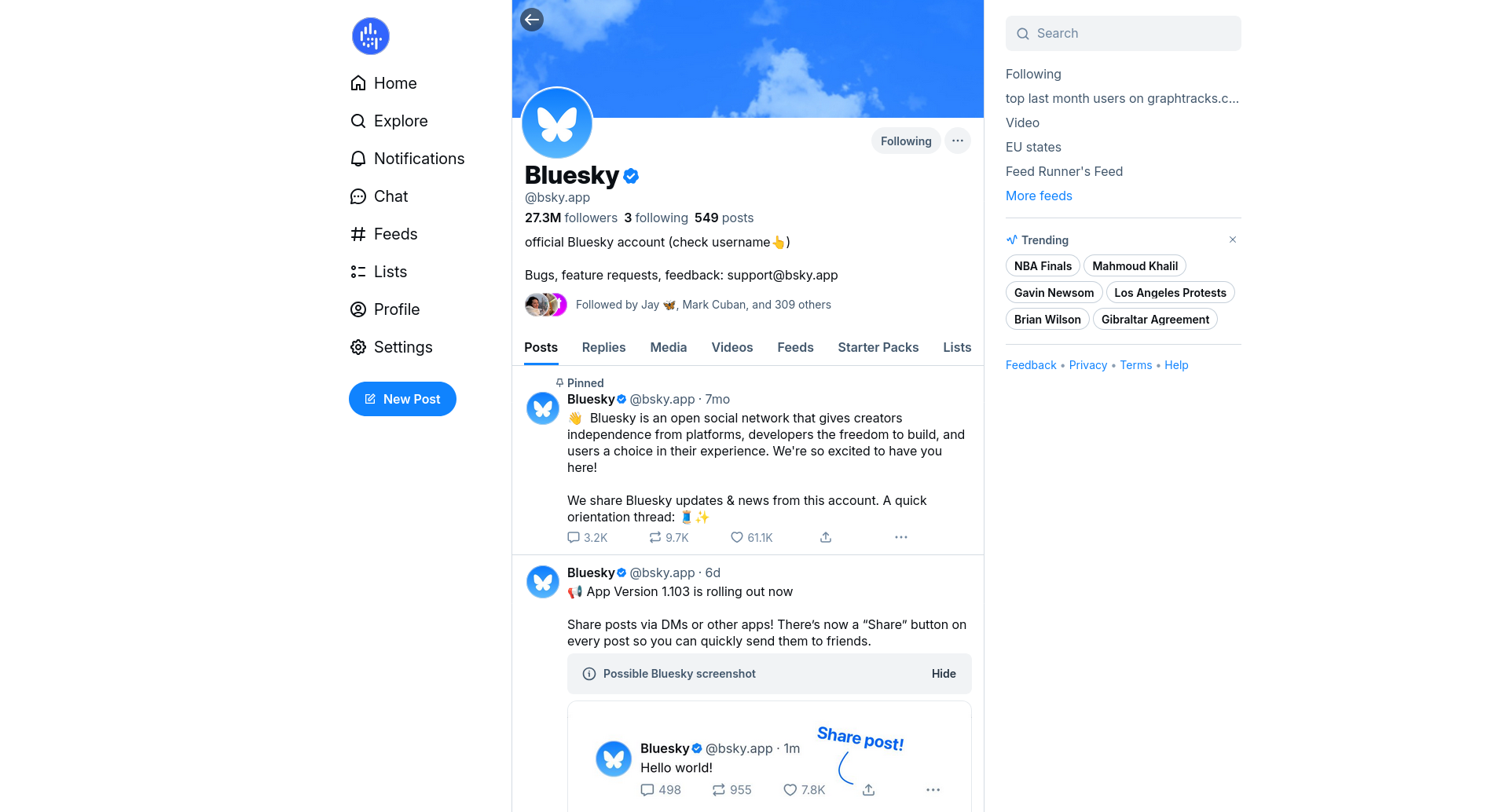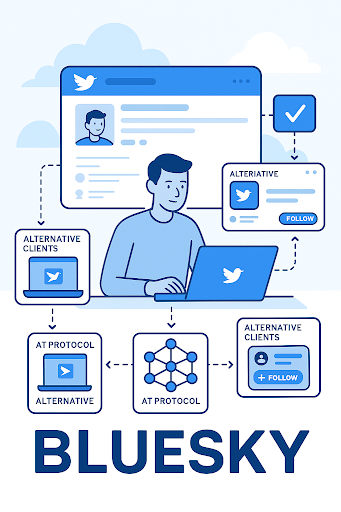
Bluesky app and software - what it is, how it works, and why it matters
Discover what the Bluesky app and software are, how they differ from traditional platforms, and what the decentralized AT Protocol means for users, developers, and creators.
Bluesky app and software
As the demand for privacy-focused, decentralized communication grows, a new class of social platforms is rising to meet it. Among them is Bluesky — a project that has captured widespread attention for its open-source architecture, user-first philosophy, and unique protocol. Whether you’re hearing about Bluesky for the first time or trying to understand how it compares to traditional social networks, this guide explores both the Bluesky app and software in depth, from its technical framework to practical user experience.
What is Bluesky?
What is Bluesky? At its core, Bluesky is a decentralized social media initiative originally incubated within Twitter. It was founded to develop an open protocol that would allow diverse social platforms to interoperate while maintaining user control and transparency. Unlike conventional platforms, where one company dictates moderation, algorithms, and account data, Bluesky aims to distribute power across a broader network using the AT Protocol (Authenticated Transfer Protocol).
The project emerged out of a growing concern over platform monopolies and algorithmic manipulation. By moving away from centralization, Bluesky empowers users to take back control over their data, feeds, and identity.
What is the Bluesky app?
So, what is the Bluesky app specifically? The Bluesky app is the flagship client for the AT Protocol. It provides a user-friendly interface for posting updates, following people, interacting with posts, and customizing content discovery. Visually, it feels similar to Twitter — but under the hood, it is fundamentally different.
With the Bluesky app, users are no longer locked into a single service provider. Instead, they can export their identity and content to another compatible app or server. This level of account portability is a revolutionary step forward in social networking.
Currently available for iOS, Android, and web, the Bluesky app continues to evolve with frequent updates that improve functionality, security, and user customization. As the protocol matures, users can expect integration with multiple clients, enabling a competitive and diverse user experience across applications.
Importantly, Bluesky is not limited to a single official application. Thanks to its open protocol, users can access the network using third-party clients built by independent developers. These alternative apps may offer different interfaces, moderation policies, or community tools — all while staying connected to the same decentralized social graph. This approach reinforces Bluesky’s goal of openness, choice, and user control.
What is Bluesky app used for?
Many new users ask, what is Bluesky app used for? The answer goes beyond “just another social network.” Bluesky is designed for open dialogue, transparency, and long-term digital autonomy. Specifically, users can:
- Post updates (known colloquially as “skeets”)
- Repost, like, and comment on others’ posts
- Build personalized timelines with algorithmic flexibility
- Create content without being subject to corporate content moderation policies
- Carry their profiles between apps or hosts built on the same protocol
It’s especially valuable for creators, developers, and community organizers who seek a platform where control isn’t dictated by one company’s terms of service. The app fosters a strong culture of experimentation, dialogue, and feedback.
What is Bluesky software?
Now, what is Bluesky software, exactly? This refers to the underlying technological stack that powers the app and the broader decentralized ecosystem. At the heart of it is the AT Protocol — an open, composable framework that defines how users identify themselves, publish content, and interact across services.
Bluesky software components include:
- PDS (Personal Data Server): Allows users or providers to host their own did keys identity and data.
- Relay system: Enables federation by sharing posts across compatible instances. Feeds data from many PDS.
- AppView layer: Helps organize posts, replies, and interactions from a protocol-level feed into usable social timelines. Moderation applies on this level.
- PLC Directory: PLC is a persistent global identifier system, which allows accounts to retain relationships while changing names or migrating between service providers.
This modular approach enables a wide range of applications to be built on the same protocol while maintaining interoperability. Developers can create apps that cater to niche audiences or build moderation services, all while sharing a common user graph.
Additionally, all of Bluesky’s code is open source. This transparency allows developers to audit, fork, and contribute to the ecosystem. For those interested in sovereignty and decentralization, Bluesky software offers more than an app — it provides infrastructure for a new kind of internet.

What is the My Bluesky app?
The phrase “what is the My Bluesky app” often appears in searches but is slightly misleading. There is no separate product with that exact name. Most often, it refers informally to an individual’s experience using the Bluesky app — their account, their feed, their settings.
As Bluesky expands, this naming may become more relevant. Since users can connect to Bluesky through various clients, “My Bluesky App” might refer to the specific interface or setup a user prefers. For example, in the future, someone may use an app branded by a third party but still interact with the same decentralized network.
Understanding that “my Bluesky app” isn’t a distinct product but a way of referring to personalized use helps clarify the ecosystem’s flexibility.
What is Bluesky social?
Finally, what is Bluesky social? This term refers to Bluesky’s main public instance — the default app and server provided by the company at bsky.app. It’s the gateway most people use to experience the protocol, especially first-time users.
“Bluesky Social” is functionally the combination of the client app and the hosted infrastructure supporting it. However, it is not the only way to participate in the network. In the future, multiple “social apps” will exist within the Bluesky ecosystem, offering users more choices and greater control.
It’s important to understand this distinction because it reflects the long-term vision: Bluesky is not a single platform but a protocol that can support many platforms.
Real-world use cases and communities
Bluesky is already home to a wide range of communities — from technologists and open-source advocates to artists, journalists, and small business owners. Here are a few examples of how it’s being used:
- Developers use Bluesky to share updates on open protocols, new tools, and independent apps.
- Content creators are exploring the platform to connect with niche audiences without algorithmic suppression.
- Privacy-conscious users migrate to Bluesky to avoid data mining and targeted ads.
- Moderation projects are being built independently to allow community-led governance instead of one-size-fits-all rules.
The diversity of use cases demonstrates the platform’s versatility and potential as a long-term solution to many of the problems centralized social media has created.

Conclusion
Bluesky represents a major shift in how social software can be designed and experienced. From its open-source architecture to customizable feeds, account portability, and user-chosen clients, the platform offers a meaningful alternative to ad-driven, centralized networks. Whether you’re exploring what is the Bluesky app, trying to understand what Bluesky software enables, or just curious about what is Bluesky app used for, one thing is clear: the decentralized social web is no longer theory — it’s live, evolving, and here to stay.
For users who want freedom from corporate algorithms, transparency in moderation, and the power to shape their own online presence, Bluesky is a compelling new direction. And for developers and innovators, it provides a fertile ground for building the next generation of human-centered digital platforms.
The Bluesky ecosystem is still in its early stages — but it’s advancing quickly. With growing communities, tools, and third-party apps, it may soon stand as a fully realized alternative to legacy social platforms. Now is the time to learn, build, and participate.
As this ecosystem grows, having the right analytics becomes essential. GraphTracks provides powerful, protocol-aware tools for tracking engagement, user behavior, and content performance across decentralized networks like Bluesky. With customizable dashboards and real-time insights, GraphTracks helps creators, developers, and marketers navigate the decentralized web with clarity and confidence. Whether you’re testing new audiences or building long-term strategy, GraphTracks equips you with the data to grow smarter.